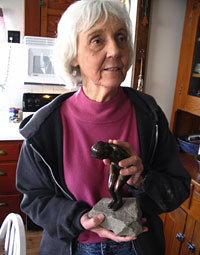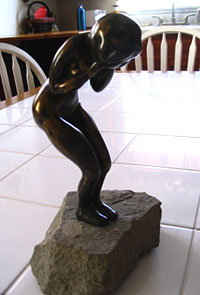Carol B. Saylor: In Her Mind's Eye
 Artist Carol Saylor
Artist Carol SaylorPhotograph by Rebecca Troutman
Carol B. Saylor discovered the sculptures of Auguste Rodin around the same time she learned she was going blind. Since that time about 25 years ago Saylor has progressively lost her eyesight in addition to losing most of her hearing. Among other hardships in her life, which included the loss of both her husband and her daughter Alice to cancer, the artist in her has only grown, adapted and flourished against all odds.
Saylor's resourcefulness was seeded in her youngest years, growing up during World War II. Her mother was an artist and her father a businessman with a penchant for woodworking. With rubber and metal materials shuttled away for the war effort, the factories were busy fabricating warheads instead of children's rubber dolls. Most of her first toys were made by her own hands.
"My parents gave us paper, my mother mixed paste with flour and water, and my brother built us a doll house," Saylor remembers. "We had the freedom and followed our parents' example."
In her adult life she was a painter and teacher at Abington Parks and Recreation in between raising five children and later, having three grandchildren. Her home is decorated with several watercolors, many of which were completed as her eyesight began to fail her.
"I would use one color at a time, or two, because I knew as a sighted person what happens to those colors," she explains. Eventually her tunnel vision became darker. "Little by little it slipped away," she says.
Saylor believes she has lost her eyesight due to RP, or "retinitis pigmentosa." Additionally, she suffers from nerve deafness, but can communicate with the help of a strong hearing aid.
"When you're blind people think you can't do a lot of things, very simple things," she explains. "For example, I wouldn't be standing on this train platform if I didn't know how to get on to the train!" she laughs.
Saylor often describes the moment she realized she could, and would, go on to make art once she lost her sight. She had been using one end of her studio with a lot of bright light for painting. Because it aggravated her eyes and back, she would often take breaks to work with a sculpture stand at the opposite end of her studio.
"I was working on a whole series of papier mache sculptures and it just hit me at once-I was working with my eyes closed," she recalls. Saylor then knew she could go on to be totally blind. "Because all that matters is the ability to make art," she says. "And I knew I could."
 Bronze sculpture by Carol Saylor
Bronze sculpture by Carol Saylor Photograph by Rebecca Troutman
Her demeanor is one of calm confidence. She has learned, through years of experience, how to visualize sculpture by touch in her mind's eye. She says it has revolutionized the way she thinks about art and about "seeing."
"Vision is spiritual, it's your mind picking up the essence of things, the feeling of things, emotion of things," says Saylor. "Seeing with your eyes is something else."
Her very first sculptures in bronze were inspired by Rodin's The Burghers of Calais , which depicts six men who sacrificed their own lives for their entire village during the Hundred Years' War. She had been taking an art class at the time and was particularly struck by the man in the back. The pose-the figure stooped over, pigeon-toed, with hands over his head in bracing agony-became her imagery to convey her feelings of impending blindness. She calls the recurring figure in her work Darkess.
Saylor currently has four pieces with bronze patinas on display through the month of April at Moss Rehab in Elkins Park, Pennsylvania. But she is most eager for a two-person show with friend, retired opthalmologist and painter Dr. Richard Goldberg. Held at Villanova University in November of 2010, she will be exhibiting the largest tactile pieces she's ever made, primarily sculpted of raku clay.
Her recent work has featured a series of large egg shapes that are meant to be touched. She often explores the space inside and adds pieces that are hard to see, but easily explored by curious hands. She believes that using a physical, tactile sense with her artwork without relying on eyesight gives an artist new meaning for the presence of their work. All it takes is practice, she insists.
"You're going to develop another level of sculpture, you're going to develop a mind's eye," she says. "I don't like to get too corny, but as a blind person you really do pick up things that sighted people don't. It's the essence of people."
Resources:
Also in this Issue:
- An Inside Look at Polich Tallix Fine Art Foundry
- Carol B. Saylor: In Her Mind's Eye
- Syed Ahmad: Capturing Fluid Movement in Glass on Copper
- Transcendence Through Copper
- MAD Museum Exhibits Elegant Armor: The Art of Jewelry
